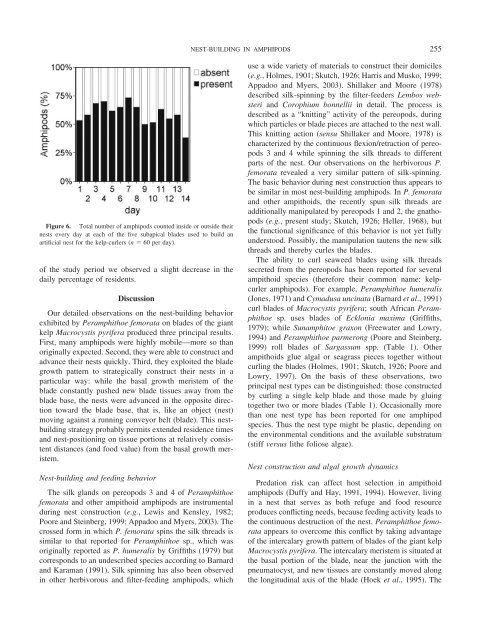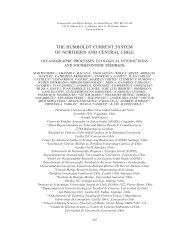Nest-Building Behavior by the Amphipod Peramphithoe ... - Bedim
Nest-Building Behavior by the Amphipod Peramphithoe ... - Bedim
Nest-Building Behavior by the Amphipod Peramphithoe ... - Bedim
Create successful ePaper yourself
Turn your PDF publications into a flip-book with our unique Google optimized e-Paper software.
NEST-BUILDING IN AMPHIPODS<br />
255<br />
Figure 6. Total number of amphipods counted inside or outside <strong>the</strong>ir<br />
nests every day at each of <strong>the</strong> five subapical blades used to build an<br />
artificial nest for <strong>the</strong> kelp-curlers (n 60 per day).<br />
of <strong>the</strong> study period we observed a slight decrease in <strong>the</strong><br />
daily percentage of residents.<br />
Discussion<br />
Our detailed observations on <strong>the</strong> nest-building behavior<br />
exhibited <strong>by</strong> <strong>Peramphithoe</strong> femorata on blades of <strong>the</strong> giant<br />
kelp Macrocystis pyrifera produced three principal results.<br />
First, many amphipods were highly mobile—more so than<br />
originally expected. Second, <strong>the</strong>y were able to construct and<br />
advance <strong>the</strong>ir nests quickly. Third, <strong>the</strong>y exploited <strong>the</strong> blade<br />
growth pattern to strategically construct <strong>the</strong>ir nests in a<br />
particular way: while <strong>the</strong> basal growth meristem of <strong>the</strong><br />
blade constantly pushed new blade tissues away from <strong>the</strong><br />
blade base, <strong>the</strong> nests were advanced in <strong>the</strong> opposite direction<br />
toward <strong>the</strong> blade base, that is, like an object (nest)<br />
moving against a running conveyor belt (blade). This nestbuilding<br />
strategy probably permits extended residence times<br />
and nest-positioning on tissue portions at relatively consistent<br />
distances (and food value) from <strong>the</strong> basal growth meristem.<br />
<strong>Nest</strong>-building and feeding behavior<br />
The silk glands on pereopods 3 and 4 of <strong>Peramphithoe</strong><br />
femorata and o<strong>the</strong>r ampithoid amphipods are instrumental<br />
during nest construction (e.g., Lewis and Kensley, 1982;<br />
Poore and Steinberg, 1999; Appadoo and Myers, 2003). The<br />
crossed form in which P. femorata spins <strong>the</strong> silk threads is<br />
similar to that reported for <strong>Peramphithoe</strong> sp., which was<br />
originally reported as P. humeralis <strong>by</strong> Griffiths (1979) but<br />
corresponds to an undescribed species according to Barnard<br />
and Karaman (1991). Silk spinning has also been observed<br />
in o<strong>the</strong>r herbivorous and filter-feeding amphipods, which<br />
use a wide variety of materials to construct <strong>the</strong>ir domiciles<br />
(e.g., Holmes, 1901; Skutch, 1926; Harris and Musko, 1999;<br />
Appadoo and Myers, 2003). Shillaker and Moore (1978)<br />
described silk-spinning <strong>by</strong> <strong>the</strong> filter-feeders Lembos websteri<br />
and Corophium bonnellii in detail. The process is<br />
described as a “knitting” activity of <strong>the</strong> pereopods, during<br />
which particles or blade pieces are attached to <strong>the</strong> nest wall.<br />
This knitting action (sensu Shillaker and Moore, 1978) is<br />
characterized <strong>by</strong> <strong>the</strong> continuous flexion/retraction of pereopods<br />
3 and 4 while spinning <strong>the</strong> silk threads to different<br />
parts of <strong>the</strong> nest. Our observations on <strong>the</strong> herbivorous P.<br />
femorata revealed a very similar pattern of silk-spinning.<br />
The basic behavior during nest construction thus appears to<br />
be similar in most nest-building amphipods. In P. femorata<br />
and o<strong>the</strong>r ampithoids, <strong>the</strong> recently spun silk threads are<br />
additionally manipulated <strong>by</strong> pereopods 1 and 2, <strong>the</strong> gnathopods<br />
(e.g., present study; Skutch, 1926; Heller, 1968), but<br />
<strong>the</strong> functional significance of this behavior is not yet fully<br />
understood. Possibly, <strong>the</strong> manipulation tautens <strong>the</strong> new silk<br />
threads and <strong>the</strong>re<strong>by</strong> curles <strong>the</strong> blades.<br />
The ability to curl seaweed blades using silk threads<br />
secreted from <strong>the</strong> pereopods has been reported for several<br />
ampithoid species (<strong>the</strong>refore <strong>the</strong>ir common name: kelpcurler<br />
amphipods). For example, <strong>Peramphithoe</strong> humeralis<br />
(Jones, 1971) and Cymadusa uncinata (Barnard et al., 1991)<br />
curl blades of Macrocystis pyrifera; south African <strong>Peramphithoe</strong><br />
sp. uses blades of Ecklonia maxima (Griffiths,<br />
1979); while Sunamphitoe graxon (Freewater and Lowry,<br />
1994) and <strong>Peramphithoe</strong> parmerong (Poore and Steinberg,<br />
1999) roll blades of Sargassum spp. (Table 1). O<strong>the</strong>r<br />
ampithoids glue algal or seagrass pieces toge<strong>the</strong>r without<br />
curling <strong>the</strong> blades (Holmes, 1901; Skutch, 1926; Poore and<br />
Lowry, 1997). On <strong>the</strong> basis of <strong>the</strong>se observations, two<br />
principal nest types can be distinguished: those constructed<br />
<strong>by</strong> curling a single kelp blade and those made <strong>by</strong> gluing<br />
toge<strong>the</strong>r two or more blades (Table 1). Occasionally more<br />
than one nest type has been reported for one amphipod<br />
species. Thus <strong>the</strong> nest type might be plastic, depending on<br />
<strong>the</strong> environmental conditions and <strong>the</strong> available substratum<br />
(stiff versus li<strong>the</strong> foliose algae).<br />
<strong>Nest</strong> construction and algal growth dynamics<br />
Predation risk can affect host selection in ampithoid<br />
amphipods (Duffy and Hay, 1991, 1994). However, living<br />
in a nest that serves as both refuge and food resource<br />
produces conflicting needs, because feeding activity leads to<br />
<strong>the</strong> continuous destruction of <strong>the</strong> nest. <strong>Peramphithoe</strong> femorata<br />
appears to overcome this conflict <strong>by</strong> taking advantage<br />
of <strong>the</strong> intercalary growth pattern of blades of <strong>the</strong> giant kelp<br />
Macrocystis pyrifera. The intercalary meristem is situated at<br />
<strong>the</strong> basal portion of <strong>the</strong> blade, near <strong>the</strong> junction with <strong>the</strong><br />
pneumatocyst, and new tissues are constantly moved along<br />
<strong>the</strong> longitudinal axis of <strong>the</strong> blade (Hoek et al., 1995). The










